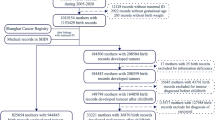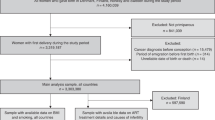Abstract
In a prospective study of 694 657 parous women in Norway, 5474 developed breast cancer after their first birth. If the first pregnancy lasted less than 32 weeks, the risk was 22% (95% confidence interval, −3% to 53%) greater than after a pregnancy of 40 weeks or more, with a significant declining trend in risk (P for trend=0.02).
Similar content being viewed by others
Main
Pregnancies generally convey protection against breast cancer, and the degree of protection depends on the woman's age at childbearing (Trichopoulos et al, 1983). An early age at first birth provides a particularly strong protective effect that is independent of the effects of subsequent pregnancies (Rosner et al, 1994). This effect has been attributed to terminal differentiation of mammary cells brought about by the hormonal milieu of pregnancy (Russo and Russo, 1999). It has been shown that pregnancies that are spontaneously or intentionally interrupted in early gestation do not provide protection against breast cancer (Melbye et al, 1997). There have been, however, no data directly addressing the hypothesis that the protective effect of a pregnancy depends on the length of gestation across the whole range of gestational age.
In this study we have combined information from two nationwide health registries in Norway in order to examine whether length of gestation is related to breast cancer risk. Data were derived from the Medical Birth Registry that comprises all births since 1967, and the Norwegian Cancer Registry, which has registered incident cancers since 1953. Midwives and doctors have to fill in a standardised form to notify the Birth Registry about each birth that takes place in the country, and the reporting of new cancers to the Cancer Registry is also mandatory. Length of gestation, based on the last menstrual period, was recorded in more than 90% of all pregnancies, and included pregnancies lasting from 154 to more than 300 days of gestation. In the analysis, length of gestation was categorised into four separate categories.
We used the unique national identification number to link women registered at the Medical Birth Registry and the national Cancer Registry to identify women who had developed breast cancer subsequent to giving birth. A total of 695 873 women had been registered with a first pregnancy between 1967 and the end of 1998, for whom length of gestation and infant birth weight had been recorded. Of those, 1216 were excluded from analysis, either because they had a diagnosis of cancer recorded prior to their first birth, or because they had emigrated and could not be traced. Thus, we have followed 694 657 women from their first birth in 1967 or later until the diagnosis of cancer, death from any cause, or to the end of follow-up (December 31, 1998), whichever occurred first. We examined whether breast cancer risk differed between women who had different length of gestation in their first pregnancy. In the analysis, we adjusted for attained age (nine categories), calendar period of diagnosis (three categories), age at first birth (five categories), and number of subsequent births (five categories), using Poisson regression modelling (EPICURE, Seattle, WA, USA; Hirosoft Int Corp, 1993).
We found, as expected (Trichopoulos et al, 1983; Rosner et al, 1994), a gradual increase in breast cancer risk with increasing age at first birth (Table 1), and an additional protection with increasing number of births (data not shown). However, increased length of gestation in the first pregnancy was strongly and independently related to reduction in breast cancer risk (Table 2). A relatively short pregnancy of less than 32 weeks was associated with a 22% (95% confidence interval, −3 to 53%) higher risk of breast cancer than a full term pregnancy of 40 weeks or more. The increase in risk related to shorter length of gestation displayed, a consistent pattern across the range of gestational age (P for trend=0.02).
This large prospective study is based on linkage between reliable data from two established national registries (Irgens, 2000), and it is unlikely that selection or information bias could have influenced the results. Our findings indicate that the protection against breast cancer depends on the duration of exposure to pregnancy, and that there is no threshold effect after a length of gestation of about 30 weeks. Combined with the evidence that pregnancies stimulate the terminal differentiation of mammary cells (Russo and Russo, 1999), these findings could be useful for our understanding of how breast cancer occurs and how it could be prevented.
Change history
16 November 2011
This paper was modified 12 months after initial publication to switch to Creative Commons licence terms, as noted at publication
References
Irgens LM (2000) The medical birth registry of Norway. Epidemiological research and surveillance throughout 30 years. Acta Obstet Gynecol Scand 79: 433–439
Melbye M, Wohlfahrt J, Olsen JH, Frisch M, Westergaard T, Helweg-Larsen K, Andersen PK (1997) Induced abortion and the risk of breast cancer. N Engl J Med 336: 81–85
Rosner B, Colditz GA, Willett WC (1994) Reproductive risk factors in a prospective study of breast cancer: the Nurses' Health Study. Am J Epidemiol 139: 819–835
Russo J, Russo IH (1999) Cellular basis of breast cancer susceptibility. Oncol Res 11: 169–178
Trichopoulos D, Hsieh C-c, MacMahon B, Lin T-m, Lowe CR, Mirra AP, Ravnihar B, Salber EJ, Valaoras VG, Yuasa S (1983) Age at any birth and breast cancer risk. Int J Cancer 31: 701–704
Acknowledgements
We thank the women who participated in the study, the Medical Birth Registry and the Cancer Registry in Norway for providing the data, and the Norwegian Cancer Society for financial support.
Author information
Authors and Affiliations
Corresponding author
Rights and permissions
From twelve months after its original publication, this work is licensed under the Creative Commons Attribution-NonCommercial-Share Alike 3.0 Unported License. To view a copy of this license, visit http://creativecommons.org/licenses/by-nc-sa/3.0/
About this article
Cite this article
Vatten, L., Romundstad, P., Trichopoulos, D. et al. Pregnancy related protection against breast cancer depends on length of gestation. Br J Cancer 87, 289–290 (2002). https://doi.org/10.1038/sj.bjc.6600453
Received:
Accepted:
Published:
Issue Date:
DOI: https://doi.org/10.1038/sj.bjc.6600453
Keywords
This article is cited by
-
Hypertensive conditions of pregnancy, preterm birth, and premenopausal breast cancer risk: a premenopausal breast cancer collaborative group analysis
Breast Cancer Research and Treatment (2023)
-
Prognosis of pregnancy-associated breast cancer: inferior outcome in patients diagnosed during second and third gestational trimesters and lactation
Breast Cancer Research and Treatment (2022)
-
Maternal breast cancer risk in relation to birthweight and gestation of her offspring
Breast Cancer Research (2018)
-
Hypertensive diseases in pregnancy and breast cancer risk
British Journal of Cancer (2012)
-
Variation in breast cancer risk associated with factors related to pregnancies according to truncating mutation location, in the French National BRCA1 and BRCA2 mutations carrier cohort (GENEPSO)
Breast Cancer Research (2012)



